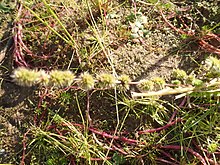Elytrophorus spicatus
Elytrophorus spicatus (common name spikegrass)[4] is a small plant in the Poaceae family native to Africa, the Indian subcontinent, south-east Asia and Australia.[3]
| Elytrophorus spicatus | |
|---|---|
 | |
| Scientific classification | |
| Kingdom: | Plantae |
| Clade: | Tracheophytes |
| Clade: | Angiosperms |
| Clade: | Monocots |
| Clade: | Commelinids |
| Order: | Poales |
| Family: | Poaceae |
| Genus: | Elytrophorus |
| Species: | E. spicatus |
| Binomial name | |
| Elytrophorus spicatus | |
 | |
| Occurrence data from GBIF | |
| Synonyms[3] | |
|
Dactylis spicata Willd. | |
Description
Elytrophorus spicatus is a tufted, annual or perennial plant with bristly culms. The leaves are loosely sheathed, and the blades are rolled in bud. The inflorescence spike (length of up to 26 cm by 5–9 mm wide) consists of globular clusters of spikelets, which are 4 mm long, with bisexual florets. The glumes are shortly awned, about 2 to 3 mm long, and have translucent margins translucent which are sparingly fringed with hairs. The awn and keel are rough. The plant flowers in response to flooding or rain.[5]
Distribution
It is native to Bangladesh, Benin, Botswana, Burkina, Cameroon, Chad, China, East Himalaya, Eritrea, Ethiopia, Ghana, Guinea-Bissau, Hainan, India, Ivory Coast, Lesser Sunda Is., Mali, Mauritania, Myanmar, Namibia, Nepal, Australia, Niger, Nigeria, Senegal, South Australia, Sri Lanka, Sudan, Tanzania, Thailand, Togo, Vietnam, Himalaya, Zambia, and Zimbabwe.[3]
Habitat
It is found in damp soil along creeks, in damp hollows, in seepages,[4] and in and near water.[5]
Taxonomy
It was first described as Dactylis spicata by Carl Ludwig Willdenow in 1801.[1][6] It was assigned to the genus, Elytrophorus, by Aimée Antoinette Camus in 1923.[1][2]
References
- "Elytrophorus spicatus". Australian Plant Name Index (APNI), IBIS database. Centre for Plant Biodiversity Research, Australian Government.
- Camus, A.A. (1923). Lecomte, P.H. (ed.). "E. spicatus". Flore Generale de l'Indo-Chine. 7: 547.
- "Elytrophorus spicatus (Willd.) A.Camus | Plants of the World Online | Kew Science". Plants of the World Online. Retrieved 29 June 2020.
- Linder, H.P. (2020). "Elytrophorus spicatus". Flora of Australia. Canberra: Australian Biological Resources Study, Department of Agriculture, Water and the Environment. Retrieved 30 June 2020.
- S. W. L. Jacobs & K. L. McClay (1993). "PlantNET - FloraOnline: Elytrophorus spicatus". plantnet.rbgsyd.nsw.gov.au. Retrieved 29 June 2020.
- Willdenow, C.L. (1801). "Einige seltene Gewachse". Gesellschaft Naturforschender Freunde zu Berlin. Neue Schriften. 3: 416.